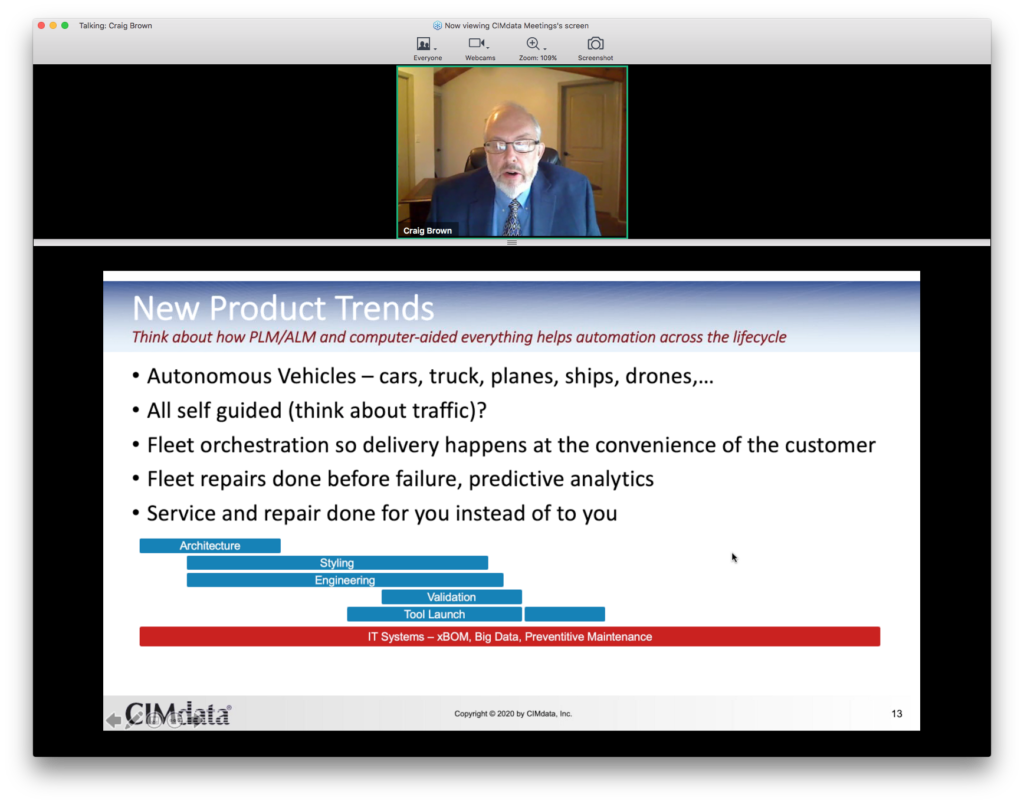
Earlier this week, another virtual session of CIMdata PLM Market and Industry Forum provided a bunch of interesting ideas and reports. While I’m digesting what I’ve seen and waited for slide decks to be share, I want to share a few interesting snippets and my thoughts.
Craig Brown, Executive Consultant at CIMdata was speaking about synching of siloed development. The topic of silos is not new for PLM readers and I addressed it multiple times in my blog. However, Craig gave to this topic an unusual context by talking about new product trends.
Check the following screenshot I captured from Craig’s slide deck. The thinking that caught my special attention was how silos are expanding. The traditional silos always presented to major elements of engineering and manufacturing resource planning. Manufacturing execution systems often came across as well, but that’s it.

Nowadays, we can see how products are expanding and additional domains need to covered to provide a comprehensive solution.
It is not enough to provide a data management platform for design and manufacturing. Products now exist in different ways – virtual and physical. The system should manage their virtual models for simulation (or how we call it now – virtual twins), but also to manage physical product instances. Data management horizons are expanding and cover maintenance and support. Tight coordination is required to bring all these data together. But this is only one dimension of the problem. Another dimension is that data is now belonging to multiple organizations – OEM, contractor, suppliers, operators, maintenance providers, and customers.
As a result, the data management challenge for such silos is a nightmare for traditional enterprise applications. PLM is one of them. PLM vendors and analysts are pointing on the name “digital thread”. While I like the name, but it is too generic and used by many PLM vendors and analysts as somewhat very blurred and as a result not manageable. The easiest approach to address digital thread gives you an idea of connected structures and pieces of information – hence the interest of PLM vendors to graph databases. But graph databases by themselves are not solving the core problem, which is a tenancy of applications. There are two things that need to be explained when the digital thread solution is coming into a play. If the digital thread is part of a single PLM platform, it is not different from existing databases. But, if the “thread” is distributed between multiple systems, it brings tons of integration elements that hard to manage.
The technology that can solve the problem is a multi-tenant platform. The easiest way to understand multi-tenancy is to check one of my earlier articles: Multi-tenant architecture and next PLM backbone and Why multi-tenant architecture will be the key to enable supply chain collaboration.
Multi-tenant architecture doesn’t solve all problems but provides an out of the box abstraction level for multiple companies to use the same platform without getting into conflicts of silos. And this is what I believe will be the key technology to solve the problem of silos for the applications of new product trends Craig Brown was talking about.
What is my conclusion?
Modern product trends demand to increase business solution coverage out of the normal boundaries of engineering and manufacturing. New solutions must include new silos of processes and information. Multi-tenant PLM architectures can provide out of the box solutions to connect silos by their nature. Connecting multiple companies, organizations, and teams (tenants), multi-tenant architectures simplifying data management and enable intelligence that nobody was able to deliver before. Just my thoughts…
Best, Oleg
Disclaimer: I’m co-founder and CEO of OpenBOM developing cloud based bill of materials and inventory management tool for manufacturing companies, hardware startups, and supply chain. My opinion can be unintentionally biased.
The post New product trends, extended silos, and multi-tenant PLM platforms appeared first on Beyond PLM (Product Lifecycle Management) Blog.



Be the first to post a comment.